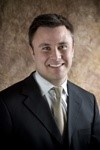Bend, Oregon
In just over two years, Bend, Oregon has seen major benefits to restructuring its emergency response system, including reduced response times, increased reliability and an improvement in gender balance in fire department staff.
But much of this would not have happened without the support and skilled management tactics of professional City Manager, Eric King, according to Drew Norris, administrative captain and basic life support (BLS) program manager with the Bend Fire and Rescue Department.
King was instrumental in the successful implementation of a tiered response system that has enlisted the help of several basic life support EMTs or ambulance operators. King fosters creative thinking at all levels of the city, and offers the perspective of the practical possibilities of the proposal, said Norris.
As the city investigated using BLS staff to alleviate emergency responders of the most basic calls, King posed questions to Fire Chief, Larry Langston, which materially helped hone a proposal that would win the favor of city council. He allowed Langston to bring an emergency physician with powerful supporting testimony to a council meeting, and worked with the chief to keep the focus on how the project would help city operations, create cost savings and better serve the community.
“Thanks goes to the voters who in 2014 supported an operating levy that allowed us to hire Basic Life Support ambulance crews,” said King. “The levy allowed us to change the way we do business. This new program helps the City provide public safety services more efficiently and responsibly.”
“I’m proud of the innovative leadership in Bend Fire who have earned tremendous support and trust from the community that they serve by reducing costs, improving response times and having exceptional survivability rates in cardiac arrest calls,” King added.
Levy Approved
In May, 2014, the Bend (pop. 83,500) voters approved a local option levy to launch a new tiered emergency response system that keeps advanced life support (ALS) units available for life-threatening emergencies. Eighty-one percent of fire department calls are EMS i n nature but 40 percent are not life threatening and are suitable for BLS trained EMTs/ambulance operators.
n nature but 40 percent are not life threatening and are suitable for BLS trained EMTs/ambulance operators.
The new BLS system uses appropriately trained ambulance operators to respond to less critical medical calls. As the BLS ambulance operators respond to an incident, a paramedic also responds in a separate Quick Response Vehicle (QRV) or engine to give advanced life support when necessary. The paramedic provides direct clinical oversight for appropriate triage by the EMTs. Assessment, treatment interventions, and transport are provided for all patients. A QRV medic serves dual roles, with the ability to join an engine crew to augment staffing in the event of a fire emergency.
The first BLS medic and QRV were placed in service in May, 2015 and the second in January 2016. The units are deployed at slightly more than half the cost of a fully manned ALS unit.
Response times have decreased by more than 90 seconds, despite an increase in call volume, tourism and road construction. Station reliability increased by 80%, keeping advanced life support apparatus available for true life threatening. Norris expects the positive trend to continue.
The EMTs or ambulance operators, are hired as limited term (less than three years) employees, allowing the city to pay a reduced rate but still offer great service. Another major consideration in switching to this new plan was the need for these new employees to be non-represented, which also keeps costs down. The local firefighters union was in full support of this idea and participated in planning for the system. The Bend Firefighters Association and the city viewed this concept as a cost-effective way to give top-notch medical care and to keep the advanced units for critical emergencies.
While this system is based on models used elsewhere, it has been modified for Bend and will be evaluated continually to make sure goals are met, Norris said. The QRV concept is a completely new idea and other departments in the Northwest are observing the program to measure its effectiveness and assess its suitability for their departments.
Program Benefits
The city has experienced several positive results from the BLS program:
- Reduced overall response times, from 9:13 to 7:40 minutes;
- Increased in station reliability by 80%. This means fire trucks and ambulances in station and available to respond to life threatening emergencies or fires;
- Offloaded 40% of the call volume from ALS medics to BLS ambulance operators; and
- Employed five female basic level EMTs improving gender balance. In 2014 one female worked in the department of 64. Today 6 of the 92 staff are female and 20% of the ambulance operators are female.
“It’s exciting to see the impression that it makes on young women when they see women in ambulances and fire trucks and that that’s something they are capable of doing,” says Ali Small, a new Bend BLS EMT. Watch a video about her and the other female ambulance operators here. The city created several other videos about the program, listed here:
https://www.youtube.com/watch?v=Ac5RGcdm7R8
https://www.youtube.com/watch?v=ykxV_S9NaP8
https://www.youtube.com/watch?v=WSgl3qx_F8U
Meet the Manager

